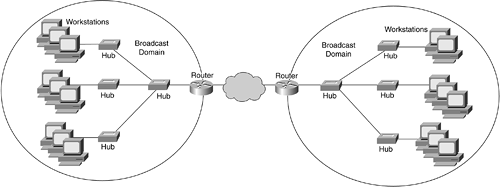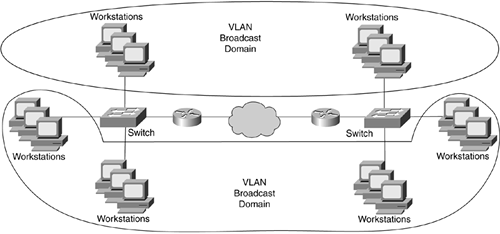VLAN Overview
A virtual LAN, or VLAN, is a group of computers, network printers, network servers, and other network devices that behave as if they were connected to a single network.
In its basic form, a VLAN is a broadcast domain. The difference between a traditional broadcast domain and one defined by a VLAN is that a broadcast domain is seen as a distinct physical entity with a router on its boundary. VLANs are similar to broadcast domains because their boundaries are also defined by a router. However, a VLAN is a logical topology, meaning that the VLAN hosts are not grouped within the physical confines of a traditional broadcast domain, such as an Ethernet LAN.
If a network is created using hubs, a single large broadcast domain results, as illustrated in Figure 8-2.
Figure 8-2. Two Broadcast Domains Connected Across a WAN

Because all devices within the broadcast domain see traffic from all other devices within the domain, the network can become congested. Broadcasts are stopped only at the router, at the edge of the broadcast domain, before traffic is sent across the wide-area network (WAN) cloud.
If the network hubs are replaced with switches, you can create VLANs within the existing physical network, as illustrated in Figure 8-3.
Figure 8-3. Two VLANs Connected Across a WAN

When a VLAN is implemented, its logical topology is independent of the physical topology, such as the LAN wiring. Each host on the LAN can be assigned a VLAN identification number (ID), and hosts with the same VLAN ID behave and work as though they are on the same physical network. This means the VLAN traffic is isolated from other traffic, and therefore all communications remain within the VLAN. The VLAN ID assignment made by the switches can be managed remotely with the right network management software.
Depending on the type of switching technology used, VLAN switches can function in different ways; VLANs can be switched at the data link (Open System Interconnection [OSI] model Layer 2) or the network layer (OSI model Layer 3). The main advantage of using a VLAN is that users can be grouped together according to their network communications requirements, regardless of their physical locations, although some limitations apply to the number of nodes per VLAN (500 nodes). This segmentation and isolation of network traffic helps reduce unnecessary traffic, resulting in better network performance because the network is not flooded. Don't take this advantage lightly, because VLAN configuration takes considerable planning and work to implement; however, almost any network manager will tell you it is worth the time and energy.
note
An end node can be assigned to a VLAN by inspecting its Layer 3 address, but a broadcast domain is a Layer 2 function. If a VLAN is switched based on Layer 3 addressing, it is in essence routed. There are two basic differences between routing and switching: First, the decision of forwarding is performed by the application-specific integrated circuit (ASIC) at the port level for switching versus the reduced instruction set circuit (RISC) or main processor for routing; second, the information used to make the decision is located at a different part of the data transfer (packet versus frame). |






